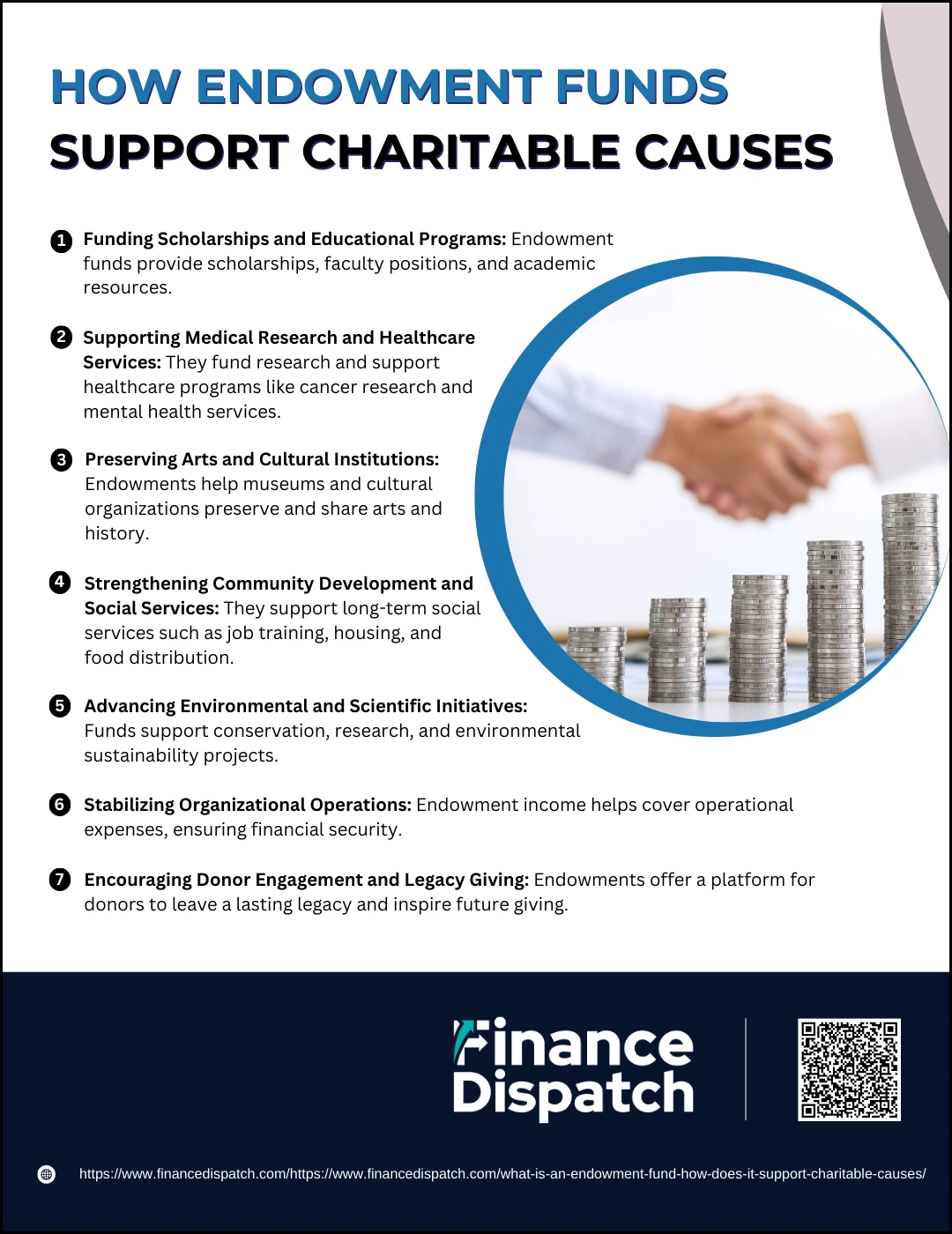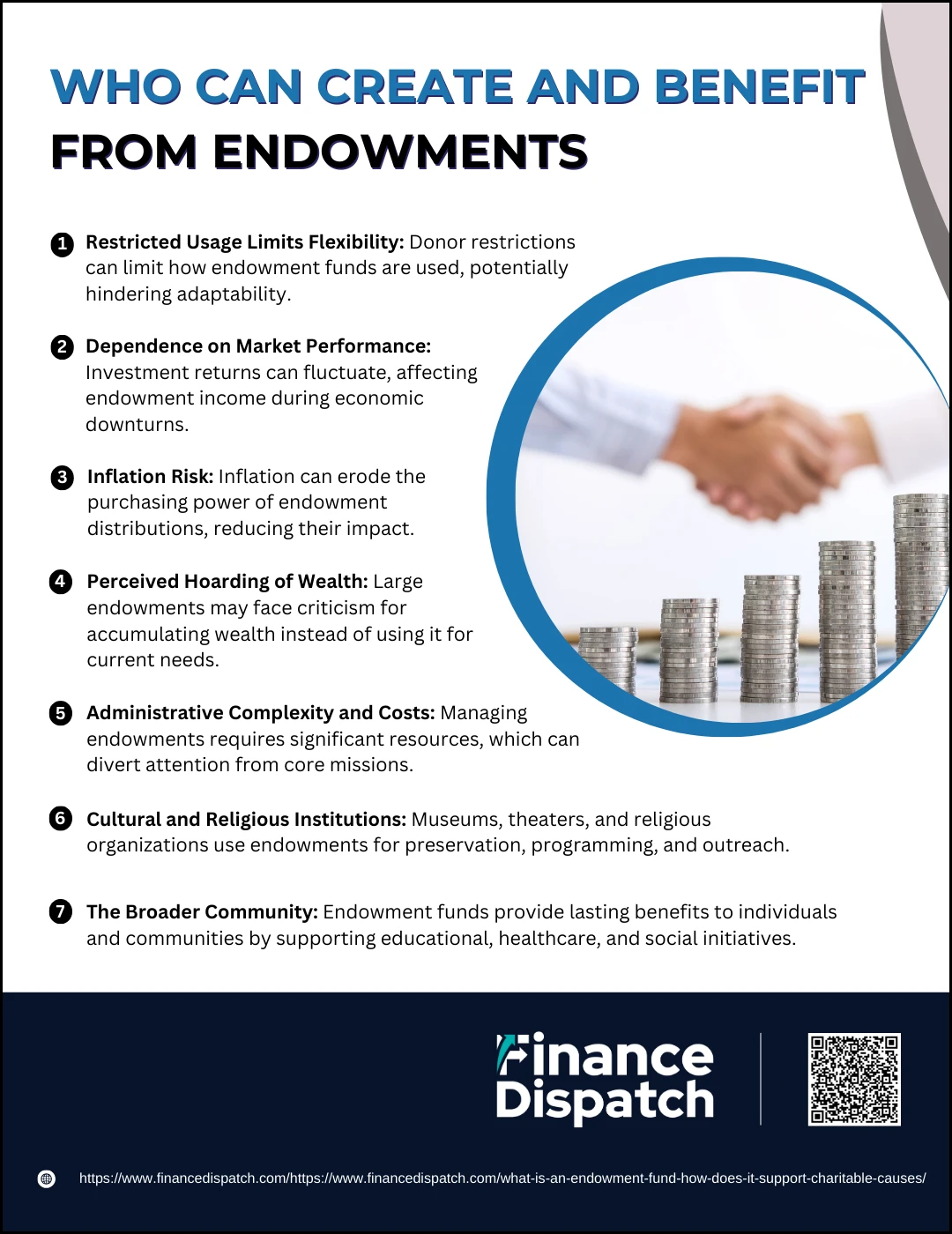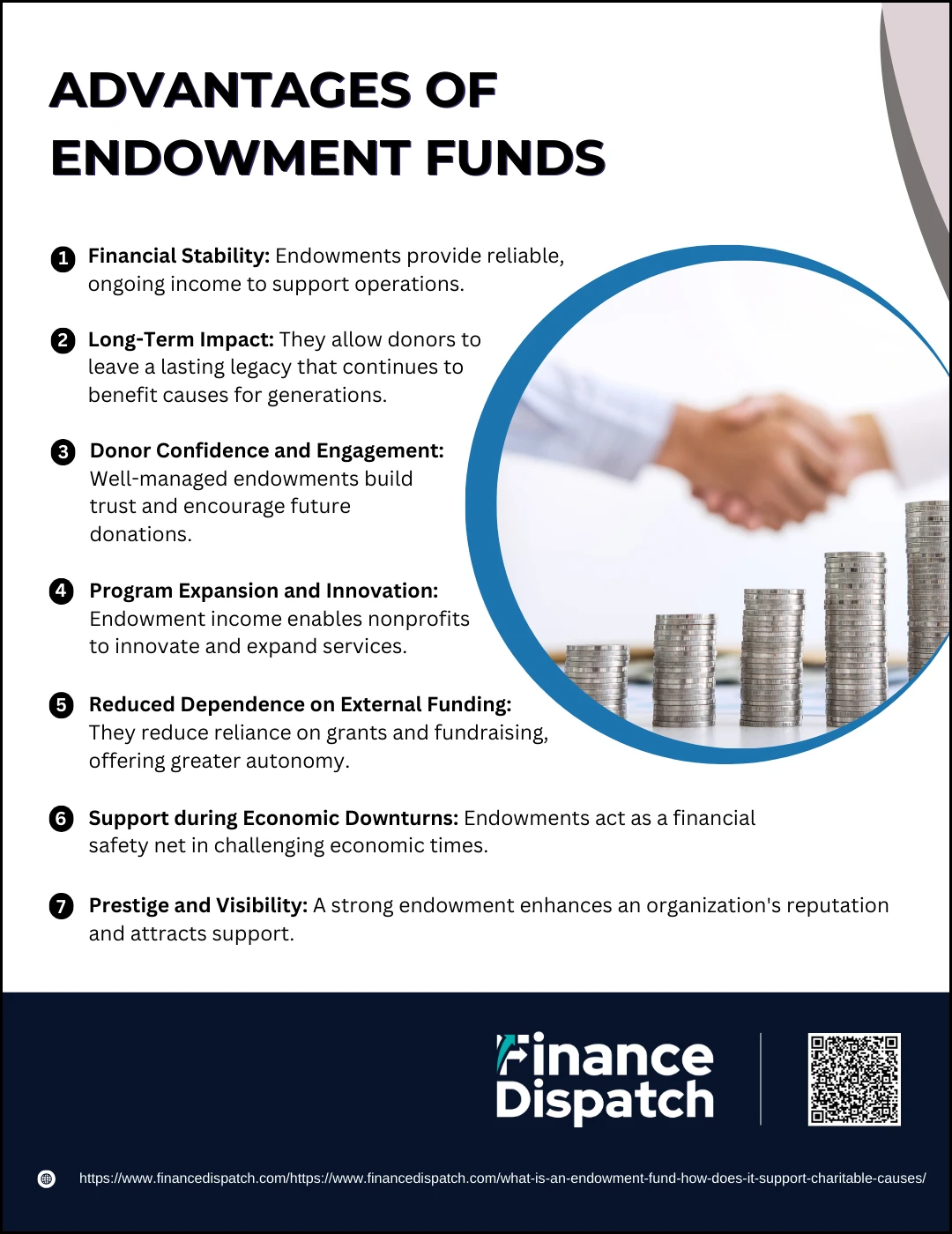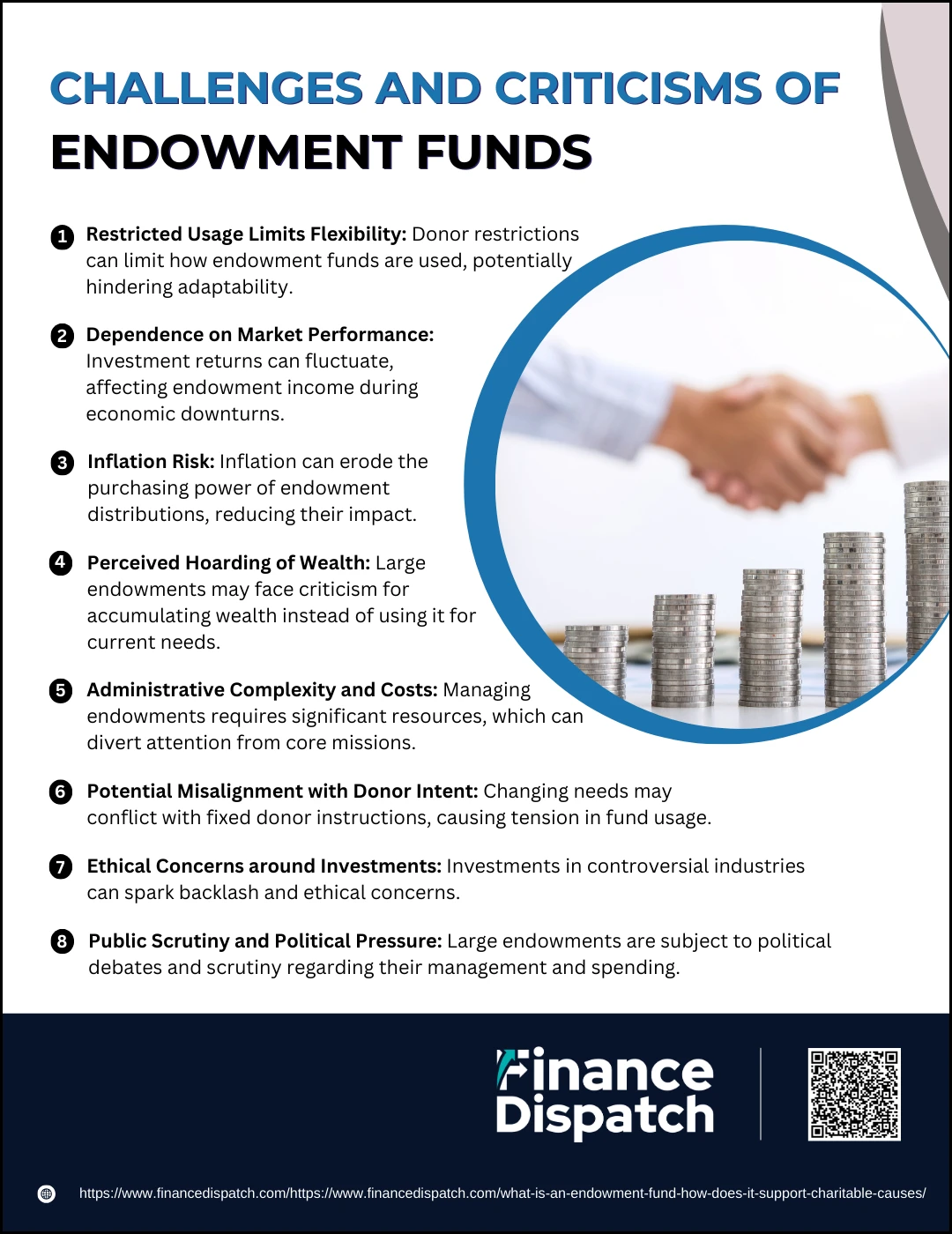An endowment fund is more than just a financial tool—it’s a powerful vehicle for long-term impact. Commonly used by nonprofit organizations such as universities, hospitals, museums, and community foundations, an endowment fund is a pool of donated assets invested to generate income while preserving the principal. The income earned is used year after year to support mission-driven initiatives, allowing donors to create a lasting legacy. In this article, we’ll explore what an endowment fund is, how it operates, and the vital role it plays in sustaining charitable causes across generations.
What Is an Endowment Fund?
An endowment fund is a dedicated pool of financial assets donated to a nonprofit organization, designed to provide long-term support for its mission. These funds are typically invested, with the goal of generating income that can be used for specific purposes outlined by the donor or governing body. What makes an endowment unique is that the original gift—often called the principal or corpus—is usually preserved in perpetuity, meaning only the investment earnings are spent. Endowment funds can support a wide range of causes, from educational scholarships and medical research to cultural programs and social services, making them an essential pillar of sustainable charitable giving.
 How Endowment Funds Work
How Endowment Funds Work
Endowment funds are designed to provide nonprofit organizations with a stable, long-term financial foundation. Unlike regular donations that are spent immediately, endowment gifts are invested so that the income they generate can support the organization year after year. The idea is to preserve the original donation—known as the principal—so it can produce a continuous stream of revenue far into the future. This makes endowments a powerful tool for sustaining missions, expanding programs, and ensuring financial resilience, even during economic downturns. Here’s a step-by-step look at how they function:
1. Donations Are Collected
The process begins when donors—individuals, families, corporations, or philanthropic foundations—contribute assets to the endowment. These donations can include cash, publicly traded stocks, bonds, mutual funds, or even real estate and business interests.
2. Funds Are Invested
The donated assets are pooled together and invested in a carefully managed portfolio, which typically includes a mix of stocks, bonds, and alternative investments. Investment decisions are guided by a formal policy designed to balance growth and risk, ensuring the fund can endure for generations.
3. Income Is Generated
As the investments grow, they produce income in the form of dividends, interest, and capital appreciation. This income becomes the resource used to fund the nonprofit’s initiatives.
4. A Spending Rate Is Applied
Most institutions implement an annual spending rule—commonly 4% to 5% of the fund’s average value over a multi-year period—to determine how much of the income can be used. This protects the endowment from short-term market volatility and helps it maintain purchasing power over time.
5. Distributions Support the Mission
The income withdrawn is used in line with the donor’s original intent or the organization’s priorities. It might fund student scholarships, medical research, arts programs, faculty positions, or social services depending on the endowment’s purpose.
6. The Principal Remains Intact
The cornerstone of an endowment is that the original donation (the corpus) is preserved. This ensures that the fund continues to generate income well into the future, securing a legacy of ongoing impact.
 How Endowment Funds Support Charitable Causes
How Endowment Funds Support Charitable Causes
Endowment funds are a powerful and enduring source of support for charitable causes. Unlike short-term fundraising or grant cycles, endowments generate sustainable income that organizations can rely on for decades—or even centuries. By preserving the original gift and distributing only the investment income, these funds allow nonprofits to plan strategically, invest in innovation, and weather economic uncertainty without compromising their core mission. Whether established by an individual donor or an institution, endowments ensure that charitable goals continue to be met long after the initial donation is made. Here’s how they make a real difference in the world:
1. Funding Scholarships and Educational Programs
Educational institutions often rely on endowments to provide scholarships and fellowships for students, especially those from underserved backgrounds. These funds can also support tutoring programs, curriculum development, faculty positions, and even capital improvements like new classrooms or labs, helping institutions build stronger academic communities.
2. Supporting Medical Research and Healthcare Services
Endowment income helps hospitals and research institutions invest in breakthrough medical technologies, fund critical research, and improve patient care. For example, endowed funds might finance cancer research, purchase life-saving equipment, or support mental health programs—providing stability even when public funding is limited.
3. Preserving Arts and Cultural Institutions
Museums, theaters, orchestras, and libraries use endowment funds to preserve historical artifacts, stage performances, and expand access to cultural resources. This support ensures that future generations can experience the arts, often at low or no cost, especially in communities where such resources are scarce.
4. Strengthening Community Development and Social Services
Endowments enable nonprofits to offer long-term services like job training, housing support, food distribution, and youth mentorship programs. By ensuring consistent funding, these organizations can maintain and scale operations that address poverty, social inequality, and community wellness.
5. Advancing Environmental and Scientific Initiatives
Environmental and science-focused organizations use endowment proceeds to protect natural resources, fund ecological research, and promote sustainability initiatives. Whether it’s conserving endangered species or educating communities about climate change, endowments provide the stability needed to carry out multi-year projects with long-term impact.
6. Stabilizing Organizational Operations
A steady stream of endowment income helps nonprofits cover operational expenses, such as staff salaries, rent, technology upgrades, and maintenance. This financial security allows them to focus on their mission rather than the constant pressure of raising new funds.
7. Encouraging Donor Engagement and Legacy Giving
Endowment funds attract donors who wish to make a lasting contribution. Whether it’s naming a scholarship, supporting a specific cause, or honoring a loved one, endowments offer a way for donors to align their personal values with long-term impact. They also inspire future generations of giving by reinforcing a culture of philanthropy.
Key Policies That Govern Endowment Funds
To ensure long-term sustainability and proper use of funds, every endowment operates under a set of carefully crafted policies. These guidelines help nonprofit organizations manage investments wisely, withdraw funds responsibly, and apply the income in ways that align with both donor intentions and institutional goals. By adhering to these policies, organizations maintain the integrity of the endowment and secure its ability to support charitable missions for generations. Here are the three key policies that govern endowment funds:
1. Investment Policy
This policy outlines how the endowment’s assets should be invested. It sets parameters for asset allocation (such as the mix of stocks, bonds, and alternative investments), risk tolerance, and long-term return objectives. The goal is to grow the fund over time while preserving the principal and ensuring liquidity for annual distributions.
2. Withdrawal Policy
The withdrawal or spending policy defines how much of the endowment can be spent each year. Most institutions limit annual withdrawals to a fixed percentage—commonly between 4% and 5% of the fund’s average value—ensuring that the fund can continue generating income without depleting the principal.
3. Usage Policy
This policy governs how the distributed income can be used. It ensures that spending aligns with the donor’s intentions and the organization’s mission. Usage may be unrestricted or restricted to specific purposes like scholarships, research grants, facility maintenance, or community programs, depending on the fund’s terms.
Types of Endowment Funds
Endowment funds are not one-size-fits-all. They can be structured in different ways depending on the donor’s intent, the organization’s needs, and the level of flexibility required. Each type of endowment fund has distinct rules regarding the use of the principal and income, as well as the degree of control held by the donor or the institution. Understanding these types helps both donors and nonprofits choose the most appropriate structure to ensure long-term impact. Below is a table summarizing the main types of endowment funds:
| Type of Endowment | Description |
| Restricted Endowment | The principal must be preserved permanently. Only investment income may be used, as per donor intent. |
| Unrestricted Endowment | Offers the most flexibility. Both income and principal can be used at the institution’s discretion. |
| Term Endowment | The principal can be accessed after a specified period or event, as defined by the donor. |
| Quasi-Endowment | Created by the organization itself, not the donor. The board may choose to spend principal and income. |
 Who Can Create and Benefit from Endowments?
Who Can Create and Benefit from Endowments?
Endowment funds are not limited to elite donors or large universities—they are accessible tools for anyone interested in leaving a lasting legacy. Individuals, corporations, and nonprofit organizations can all establish endowments to support causes that reflect their values and goals. These funds are designed to provide stable, long-term financial support, benefiting a wide range of recipients, from students and patients to communities and cultural institutions. Establishing an endowment not only helps an organization plan for the future but also strengthens donor relationships by offering a permanent way to make a difference. Here’s a more detailed look at who can create and benefit from endowment funds:
1. Individuals and Families
Anyone with a philanthropic mindset can create an endowment. While high-net-worth donors are the most common, even modest contributions can grow significantly over time. Families may create endowments to honor a loved one, fund causes they’re passionate about, or establish scholarships that support future generations.
2. Corporations and Businesses
Companies looking to give back to society often create endowment funds as part of their corporate social responsibility (CSR) strategies. These endowments can support community development, workforce education, healthcare access, or environmental programs that align with the company’s mission and values.
3. Foundations and Trusts
Private foundations and family trusts frequently use endowments to institutionalize their giving. These entities can distribute grants or sponsor projects with clear focus areas—such as early childhood education, cancer research, or food security—while ensuring their charitable impact continues over time.
4. Nonprofit Organizations
Many nonprofits set up quasi-endowments using unrestricted donations or board-designated funds. By building their own endowments, these organizations gain financial flexibility, create a buffer for tough times, and establish a foundation for long-term growth and innovation.
5. Educational Institutions
Schools, colleges, and universities often manage multiple endowment funds that support faculty chairs, academic programs, building projects, and student financial aid. These funds help institutions enhance their offerings, attract top talent, and reduce dependence on tuition revenue.
6. Cultural and Religious Institutions
Organizations such as museums, performing arts centers, libraries, churches, and temples use endowment income to preserve heritage, fund public programming, maintain facilities, and expand outreach. These funds help safeguard their missions for future generations.
7. The Broader Community
The ultimate beneficiaries of endowments are the individuals and communities served by the organizations they support. From a student receiving a full scholarship to a patient receiving better care or a community gaining access to social services—endowment funds enable life-changing opportunities that ripple across generations.
Real-World Examples of Endowment Impact
Endowment funds have played a transformative role in advancing education, healthcare, culture, and community development around the world. By generating consistent income, these funds empower institutions to launch new initiatives, respond to emerging needs, and remain resilient during economic downturns. From world-renowned universities to local nonprofits, the positive effects of endowments are evident in the lives they touch and the programs they sustain. Below are some real-world examples that showcase the power and impact of well-managed endowment funds:
1. Harvard University
With the largest academic endowment in the world—over $50 billion—Harvard uses its fund to support financial aid, faculty research, campus improvements, and new academic programs. In fiscal year 2023, it distributed $2.2 billion to university operations.
2. The Nature Conservancy
This environmental nonprofit has leveraged its endowment to support long-term conservation projects across the globe. It uses investment income to fund land acquisitions, habitat restoration, and climate initiatives.
3. Cleveland Clinic
The clinic’s endowment helps fund advanced medical research, state-of-the-art facilities, and patient care initiatives. In recent years, the fund has enabled nearly $500 million in philanthropic spending.
4. San Diego Foundation
With a strong focus on regional impact, this community foundation uses its endowment to support local nonprofit programs in areas like education, healthcare, housing, and the arts.
5. Smith College Botanical Garden Endowment
Smith College has a dedicated endowment to support the operations and educational mission of its botanical gardens, ensuring preservation, public access, and student engagement.
6. Princeton University
Princeton uses a portion of its endowment to fully cover tuition, room, and board for students from low-income backgrounds, helping to make higher education more accessible and equitable.
 Advantages of Endowment Funds
Advantages of Endowment Funds
Endowment funds are among the most strategic financial tools a nonprofit organization can possess. Unlike one-time donations or short-term grants, endowments are designed to provide a continuous, predictable stream of income far into the future. They help organizations move beyond reactive fundraising and operate with a long-term vision. Whether supporting scholarships, healthcare, research, or community programs, endowments offer both financial resilience and mission-driven flexibility. Here’s a closer look at the key advantages of building and maintaining an endowment fund:
1. Financial Stability
Endowments create a reliable income source that organizations can count on year after year. This stability allows nonprofits to plan ahead, manage resources more efficiently, and keep operations running smoothly even when other funding sources fluctuate or disappear.
2. Long-Term Impact
Since endowments are structured to preserve the principal, they generate returns that support charitable activities indefinitely. This enables donors to leave a legacy that continues to benefit their chosen cause well beyond their lifetime, making a meaningful difference over decades or even centuries.
3. Donor Confidence and Engagement
A well-managed endowment builds trust with current and prospective donors. It demonstrates financial discipline and a commitment to sustainability, encouraging larger gifts, planned giving, and the establishment of named funds that honor individual legacies.
4. Program Expansion and Innovation
Endowment income gives organizations the financial freedom to innovate, launch pilot programs, and expand successful services. Because the income is recurring, it allows nonprofits to explore new ideas without compromising their existing obligations.
5. Reduced Dependence on External Funding
With steady earnings from endowment investments, nonprofits can avoid excessive dependence on grants, unpredictable donor cycles, or government subsidies. This autonomy empowers organizations to focus more on their mission and less on continuous fundraising.
6. Support During Economic Downturns
Endowments can act as financial safety nets. During recessions or other economic disruptions, organizations with endowments are better positioned to maintain staff, services, and community support, helping them weather tough times without significant operational cuts.
7. Prestige and Visibility
A strong endowment enhances an organization’s reputation and credibility. In sectors like higher education, healthcare, and the arts, it signals institutional strength, attracting elite faculty, high-caliber staff, and additional supporters who are drawn to well-funded, stable organizations.
 Challenges and Criticisms of Endowment Funds
Challenges and Criticisms of Endowment Funds
Endowment funds are often praised for their ability to ensure long-term financial sustainability, but they are not without drawbacks. As these funds grow in size and prominence—especially at elite universities and large nonprofits—they have drawn scrutiny from donors, regulators, and the public. Critics argue that the very structure that makes endowments sustainable can also make them inflexible, opaque, or misaligned with current needs. Managing an endowment fund requires careful governance, transparency, and regular review to avoid financial inefficiencies and ethical pitfalls. Here are some of the most common and pressing challenges and criticisms associated with endowment funds:
1. Restricted Usage Limits Flexibility
Endowments often come with strict donor-imposed conditions on how the income can be used. While this protects the donor’s intent, it can also tie the hands of the institution, preventing it from reallocating funds during times of crisis or when needs change significantly.
2. Dependence on Market Performance
Since most endowment funds are heavily invested in the financial markets, their income depends on how well those investments perform. Economic downturns or market volatility can lead to reduced returns, forcing institutions to cut back on spending just when the need for services may be greatest.
3. Inflation Risk
Even if the fund appears to be growing, inflation can erode the value of its returns. If the investment income does not keep pace with rising costs, the purchasing power of the fund’s annual distributions may decline, reducing its effectiveness over time.
4. Perceived Hoarding of Wealth
Large endowments, especially in higher education, have faced criticism for accumulating vast sums while tuition fees rise or public services are cut. Critics argue that institutions should use a greater portion of their endowments to support students and communities now rather than focusing so heavily on perpetuity.
5. Administrative Complexity and Costs
Managing an endowment involves significant oversight, including investment management, legal compliance, regular reporting, and policy enforcement. These operational requirements can be resource-intensive and may require the organization to divert attention from its core mission.
6. Potential Misalignment with Donor Intent
Over time, the needs of a nonprofit may change, but the stipulations attached to an endowment may remain fixed. Vague or outdated donor instructions can cause friction between honoring original intentions and addressing current realities, sometimes requiring court intervention to modify terms.
7. Ethical Concerns Around Investments
Some institutions face backlash for investing endowment funds in industries perceived as socially or environmentally harmful. Student and community protests have challenged investments in fossil fuels, private prisons, or companies with questionable labor practices, urging nonprofits to adopt more socially responsible investment strategies.
8. Public Scrutiny and Political Pressure
In recent years, large endowments have become targets of political debate. Laws such as the 1.4% excise tax on wealthy university endowments have raised concerns about how these funds are managed, how much is spent annually, and whether they serve the public interest.
Conclusion
Endowment funds are a cornerstone of long-term financial sustainability for nonprofit organizations, enabling them to fulfill their missions with consistency, resilience, and strategic vision. By preserving the principal and distributing only a portion of investment income, these funds create a lasting legacy that benefits generations to come. While endowments come with certain challenges—such as restricted usage, market dependency, and ethical considerations—when managed with transparency and foresight, they can provide unmatched support for education, healthcare, arts, social services, and more. Ultimately, endowment funds are not just financial instruments—they are powerful commitments to creating meaningful, enduring change in the world.



